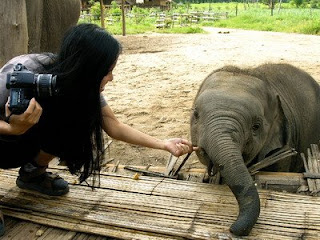I notice there isn't much written on Khao Yai National Park in here yet (or not that I could find). We, my family and I, just had a two day visit to there during Songkran and thought it was very nice. I would recommend anyone living in the area to visit.
Our access to Khao Yai National Park was through the Northern gate. As far as I know there are 2 gates that you can enter, one in the South and one in the North. All the accommodation within the park was full so we stayed in a Guest House just a few km from the gate, called Bann Kroo. Rooms in Bann Kroo cost us 300B per night and were small and simple but nice and exactly what we wanted. I thought it was a nice place and the owners were good people and I would recommend it for a simple, no fuss place to stay. There are many places to stay outside the park as well as accommodation within the park. However, within the park, the accommodation is often booked out on weekends and public holidays, so it is best to book in advance or be prepared to not stay in the park if you are there on a weekend / holiday.
Khao Yai is Thailand's oldest National Park and one of the largest. It is not far from Bangkok and contains tigers, elephants, deer, monkeys, gibbons, bears, leopards, buffalo, crocodiles and much more.
Entry to the park cost 200B for me, 50B for the car, 20B each for Kanchana and her Mum and 10B for each of the kids. We drove the car through the park, looking for animals and stopping at a couple of lookouts. It was pretty nice scenery but nothing too exciting at first with the exception of reasonably fresh looking elephant poo on the road.
In many areas I could hear gibbons calling. I found a place where I could hear gibbons; there was room to stop the car and there was a track heading into the jungle. I headed into the jungle by myself to see if I could catch a glimpse of the gibbons. Kanchana (my fiance) and the kids were still quite unsure of walking in the jungle at this stage and wouldn’t come with me. After a 5 – 10 minute walk, keeping my eyes out for tigers and snakes, of which I saw none, I found the gibbons. I could only see one although there was at least three that I could hear. Interestingly I also noticed a nest, similar to an orangutan nest, which obviously belonged to the gibbons. I hadn’t previously realised they made nests. I watched them for a while and took some poor quality photos and then headed back to the car.

During the rest of our drive we also saw deer. We then walked a little around the Park HQ an saw a small cream coloured squirrel and a giant squirrel and heard more gibbons. Oh, also saw a few small lizards.
We also had a chat to one of the park rangers which was interesting. Khao Yai National Park is attached to some other National Parks and wilderness areas, making up a fairly large area of jungle. The ranger we were speaking to worked in an area that made up about a fifth of this jungle. Over the past 4 years he has had various cameras permanently set up in his area and in that time (4 years), they have taken 4 pictures of a tiger. I couldn’t understand enough to be sure, but I think this was the same tiger each time. Hmmm, the chances of tigers surviving in the Khao Yai area seem very poor. Judging by this, there may only be 4 or 5 tigers in the Khao Yai jungle, if that many. There are still poachers coming into the park to hunt for tigers and other animals as well as to take timber and other jungle products (Is this largely for the Chinese market???). There is a considerable effort to stop this, but it has not yet been totally stopped. Just another one or two tigers killed by poachers would be enough to guarantee the extinction of tigers in this region. The ranger said about 180 elephants lived in Khao Yai National Park.
In the evening we went back to the park to do a night safari drive which cost 430B for 5 people and included a truck, driver and spotter with spot light. We had paid for this during the day and so we didn't have to pay to come back into the park. We saw a lot more deer and a civet. No elephants, which was a disappointment for Kanchana, who loves elephants.
The next morning we drove home via lunch at a waterfall somewhere near Saraburi.
Khao Yai was good and we already plan to go back.
by thai-blogs.com



















































